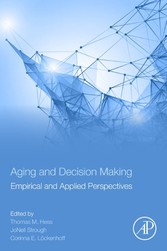
Aging and Decision Making - Empirical and Applied Perspectives
von: Thomas M. Hess, JoNell Strough, Corinna Löckenhoff
Elsevier Reference Monographs, 2015
ISBN: 9780124171558
Sprache: Englisch
429 Seiten, Download: 4083 KB
Format: EPUB, PDF, auch als Online-Lesen
Foreword∗
Decision Making and Aging: Emerging Findings and Research Needs
We are approaching a major demographic shift in the United States and globally, such that the number of individuals over the age of 65 will exceed the number under the age of 5, with no outlook for reversal of this trend in the foreseeable future (National Institute on Aging/World Health Organization, 2011). Contrary to popular stereotypes of aging, the majority of these older adults (at least in the United States) will be living at home, in the community, and will be free of dementia and major disability well into their 70s and early 80s (U.S. Census, 2014). Moreover, as many research and community surveys have revealed, as long as individuals remain in reasonably good health, life satisfaction and emotional well-being improve with age (Carstensen et al., 2011; Mroczek & Kolarz, 1998; Stone, Schwartz, Broderick, & Deaton, 2010). These observations suggest that the older adult population represents a large and potentially untapped resource in our society. But it also poses significant challenges.
Societies have begun to take a serious look at the implications of this demographic shift for policies related to health care, pensions, and retirement, among other domains. Individuals, in turn, are increasingly reminded—through the media, but also in workplaces and health-care contexts—that remaining independent into their later years will require careful planning and decision making in an array of financial and health domains. For example, the decisions that working-age adults make about retirement savings and insurance coverage in their 40s and 50s will determine their ability to sustain current lifestyles, buffer against health shocks, and provide for long-term care needs. Individuals also face decisions about health care and illness management—for themselves and for their family members—as well as decisions regarding preferences for end-of-life care in anticipation of future infirmity or incapacity. The ability to make sound decisions for the short and long term is also essential to optimal functioning in the workplace, as more individuals seek ways to extend their productive working lives into older age. These are the consequential decisions that first come to mind when considering the major decision-making challenges associated with aging.
Perhaps less salient, but no less consequential, are the multiple, small decisions taken over the course of adulthood that collectively impact quality of life at older ages. How well individuals age—and how long they live—depends in part on a series of daily decisions, often taken without much deliberation, regarding engagement in and adherence to health behaviors and regimens, or about small expenditures of financial resources, social capital, and cognitive effort, all of which exist in finite supply. These are decisions that draw on individuals’ capacity for self-regulation and self-control, their ability to keep long-term goals in mind, and their willingness to place appropriate value on their future well-being. The cumulative impact of these small choices can constrain future choices and make the difference between arriving at older age in good health, with cognitive capacity intact, and with the resources permitting the exercise of these assets in pursuit of well-being, versus encountering older age with compromised health and cognitive function, or without the financial wherewithal to address age-related challenges. How well equipped are middle-aged and older adults to make adaptive decisions across these many domains?
The chapters in this volume represent an effort to identify both the strengths and weaknesses of decision making in, and in anticipation of, older age. The authors represent perspectives on decision making that derive primarily from psychology and neuroscience, where the key questions concern the cognitive, emotional, and motivational capacities older adults bring to the decision context, and age-related changes in these processes and the neural systems that support them. This kind of basic science orientation lays essential groundwork for the design of decision-supportive interventions for adaptive aging. Throughout the volume, there is also a deep appreciation of the broad range of domains (e.g., health care, finances) and contexts (e.g., with intimate partners and family members, with health-care providers, in the consumer marketplace) in which decisions take place, and of the need for an appreciation of the interaction between individual capacities and context variables in the design of interventions.
Open Questions
Psychologists who study aging have postulated that negotiating the challenges of later life requires careful balancing of strengths gained through years of life experience and accumulated expertise, against vulnerabilities associated with the normal declines that accompany older age (Baltes, 1997; Carstensen, Isaacowitz, & Charles, 1999; Charles, 2010). Over the past decade or so, there has been a clear recognition, common across the decision sciences, of the interdependence among—and trade-offs between—cognitive capacities (which support the processing of information about alternatives, probabilities, risks, and rewards) and emotional functions (which reflect subjective values and preferences and are involved in forecasting the impact of choices on subjective well-being in the long term) (Coricelli, Dolan, & Sirigu, 2007; Rolls & Grabenhorst, 2008; Weber & Johnson, 2009). Aging throws a unique light on this interaction, as the balance of strengths and vulnerabilities shifts. There is evidence that as cognitive flexibility of youth wanes, individuals may increasingly draw on expertise, learned heuristics, and emotional maturity to tackle decisions. Whether these shifts in capacity enhance or undermine decision making is a topic of considerable research attention (Hess & Kotter-Grühn, 2011; Morrow et al., 2009). The more we learn about the specific cognitive and affective processes that account for age-related changes in decision making, the more precisely we can target interventions to compensate for vulnerabilities and leverage strengths.
Older age is also associated with both shifts in social goals and changes in social relationships and contexts. Yet our understanding of the impact of these changes on decision making remains limited. It is possible that changes in both goals and contexts affect the extent to which interpersonal processes, such as coercion, trust, competition, generativity, and empathy, influence decisions in health and financial domains (see, for example, Beadle et al., 2012; Castle et al., 2012). Age groups may also differ in the degree to which self-regarding versus other-regarding motives take priority, and in their susceptibility to the influence of peers, family members, the media, professional advisors, or service providers. Sociodemographic factors may moderate these influences, with differences in wealth, education, and occupational status exerting powerful effects both on the ability to make sound choices and on the array of choices available.
Several of the chapters in this volume highlight the importance of strategies and strategy selection for adaptive decision making. This area of inquiry holds considerable potential for research on decision making in aging. For example, research has suggested that older age is associated with improvements in emotion regulation, and that emotional regulatory strategies may underlie some age differences in decision making, yet psychologists are only beginning to explore the precise strategies that older adults bring to bear to regulate emotions (Isaacowitz & Blanchard-Fields, 2012; Urry & Gross, 2010). There is evidence to suggest that older adults are capable of employing strategies along the full emotion-regulation continuum (Gross, 1998). They engage in early-stage situation selection (Robenpor, Skogsberg, & Isaacowitz, 2013)—including avoiding situations that will lead to adverse outcomes and choosing those that promise to yield emotional rewards. They are also able, when immersed in a choice context, to selectively attend to certain information (Lohani & Isaacowitz, 2014; Löckenhoff & Carstensen, 2007). And they exhibit the ability to engage in later-stage reappraisal involving the potentially more cognitively taxing “reframing” of current experiences to facilitate better coping (Lohani & Isaacowitz, 2014; Mather, Shafir, & Johnson, 2000). Effective decision-supportive interventions may require careful analysis of decision context features and individual emotional regulatory strengths, while also accounting for biases of particular age groups—that is, a person-by-context-by-strategy framework rather than a “one size fits all” approach (Tucker, Feuerstein, Mende-Siedlecki, Ochsner, & Stern, 2012).
A Research Agenda for the Future
Interdisciplinary research on the cognitive, affective, and social influences on decision making in aging has been growing over the past decade, encouraged, in part, by research initiatives at the National Institute on Aging (2006, 2010c, 2011) and the National Institutes of Health (2010, 2012). These include efforts to stimulate research in neuroeconomics and behavioral economics of aging, as well as basic research on decision making and on mechanisms of behavior change. The integration of approaches from psychology, economics, and neuroscience in neuroeconomics is shedding new light on foundations of decision making and choice...










